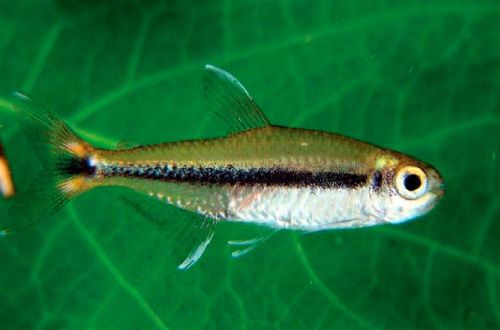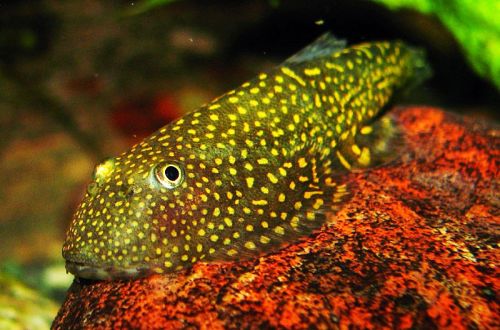
neon savannah
Savannah neon, scientific name Hyphessobrycon stegemanni, belongs to the Characins family. Unpretentious and easy to keep, it is compatible with many other fish, making it an excellent candidate for almost any freshwater aquarium.
The name of this species indicates its origin – it lives in the savannah, more precisely in a special region of South America known as Cerrado. In turn, the Latin name is associated with a baker from São Paulo, Carlos Stijmanni. This oddity is explained by the fact that his close friend was Harald Schulz (1909-1966), one of the largest explorers of the Amazon. He decided to name one of the fish he discovered in honor of his close friend, the same baker.

Contents
Habitat
It comes from South America from the middle basin of the Tocantins River, located on the territory of the Brazilian state of the same name Tocantins and Maranhao. The fish is found in the region known as the Cerrado, a vast area of tropical forest grassland that is considered the most biodiverse savannah in the world with a large number of endemic species of flora and fauna.
Fish inhabit the numerous rivers flowing through this region. Depending on the season, the water level varies greatly, as does its chemical composition. The channel consists of rocks and stones of variable size, as well as flooded tree roots, fallen leaves, branches.
Currently, due to active human activities, about half of the Serrada has been destroyed.
Brief information:
- The volume of the aquarium – from 40 liters.
- Temperature – 20-25°C
- Value pH — 5.5–7.5
- Water hardness – 1–12 dGH
- Substrate type – any
- Lighting – subdued
- Brackish water – no
- Water movement is weak
- The size of the fish is about 3 cm.
- Feeding – any food of suitable size
- Temperament – peaceful
- Keeping in a group of 8-10 individuals
Description
Adults reach a length of 2–3 cm. The color is gray with a dark horizontal stripe stretching from head to tail. Sexual dimorphism is weakly expressed, males and females are outwardly very similar to each other. The latter may appear slightly larger, especially when spawning.
Food
Unpretentious, in a home aquarium they will accept various types of food of a suitable size. The daily diet can consist exclusively of dry foods in the form of flakes, granules, provided that high-quality products from well-known manufacturers are used. A great addition would be the inclusion in the diet of small invertebrates, such as brine shrimp, daphnia, small bloodworms, etc.
Maintenance and care, arrangement of the aquarium
The optimal size of the aquarium for a flock of 8-10 fish starts from 40-50 liters. The design is arbitrary and is selected at the discretion of the aquarist or based on the needs of more “capricious” species.
High water quality is the key to successful maintenance of Neon Savannah. It is necessary to ensure stable water conditions within an acceptable range of temperatures and hydrochemical values, as well as to prevent the accumulation of products of the nitrogen cycle (ammonia, nitrites, nitrates) to dangerous concentrations. Achieving this goal largely depends on the regular maintenance of the aquarium (changing part of the water, cleaning the soil, removing organic waste, etc.) and its equipment with all the necessary equipment. First of all, this applies to the filtration system.
Behavior and Compatibility
Peaceful mobile fish, prefers to be in the company of relatives. The size of the group is desirable to maintain at least 8-10 individuals. Given its peaceful disposition and ability to adapt to different environments (compared to other neon), this species makes an excellent companion for other freshwater non-aggressive fish of comparable size.
Breeding / breeding
In nature, reproduction occurs during the rainy season, the stimulus is changes in the composition of the water. However, fish that have been living in the artificial environment of aquariums for generations have largely lost this connection, so spawning can take place all year round under favorable conditions. The lack of seasonality has led to the fact that the fish come to spawning at different times. In large flocks, fry appear almost every month.
Savannah neon does not show parental care for offspring and, on occasion, will definitely eat its own caviar and fry. To preserve the brood, fertilized eggs are timely transferred to a separate tank with identical water conditions to the main aquarium. To maintain them, a simple airlift filter with a sponge and a heater are enough. A separate light source is not required.
In the first days of life, the fry feed on the remains of the yolk sac, and then begin to swim in search of food. Since the juveniles are very small, they need microscopic food such as shoe ciliates or specialized powdered foods.
Fish diseases
Diseases inherent in this particular species of fish were not noted. When kept in suitable conditions (high water quality, balanced diet, non-conflict neighbors, etc.), health problems are not observed. The most common cause of disease is the deterioration of conditions leading to immune suppression, which makes the fish susceptible to infections that are invariably present in the surrounding area. When the first signs of an illness are detected (lethargy, exhaustion, refusal of food, lowered fins, etc.), it is necessary to immediately check the main parameters of the water. Often, the restoration of acceptable living conditions contributes to self-healing, but if the fish is too weak or has received obvious damage, medical treatment will be required. For more information on symptoms and treatments, see the Aquarium Fish Diseases section.





